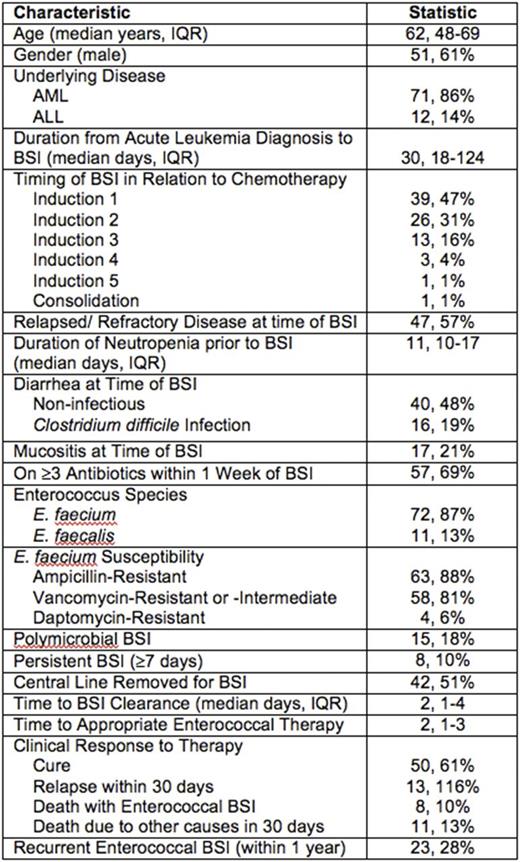Abstract
Enterococcal BSI occurs frequently in patients with acute leukemia and causes significant morbidity and mortality. Daptomycin non-susceptible Enterococcus (DNSE) infection has emerged as a threat that has limited treatment options. However, the timing of enterococcal BSI in relationship to chemotherapy is unknown. In addition, previous studies have focused on the epidemiology of vancomycin-resistant E. faecium (VRE) BSI. The present study investigates the timing of enterococcal BSI in relationship to chemotherapy and the epidemiology of both E. faecium and E. faecalis BSI in patients with acute leukemia. We hypothesize that most BSIs are gut derived, mucosal barrier injury infections that occur in patients who undergo intensive chemotherapy that causes prolonged neutropenia and chemotherapy-induced mucositis leading to febrile neutropenia and antimicrobial-induced gut dysbiosis.
We conducted a retrospective cohort study of patients with acute myeloid leukemia (AML) and acute lymphoblastic leukemia (ALL) admitted to Duke University for infusional chemotherapy from 2010-15. BSI was adjudicated by CDC criteria. Appropriate enterococcal therapy was defined as receipt of an antibiotic with in vitro activity against the BSI isolate. BSI clearance was defined by negative follow-up blood cultures obtained within 72 hours after positive blood cultures. Recurrent BSI was defined by positive blood cultures for Enterococcus after BSI clearance. Bivariate analysis was performed using chi-squared test.
Three hundred twelve patients were evaluated for this study, 83 of whom had enterococcal BSI during the study period (27%; Table 1). Eight-seven percent had BSI due to E. faecium while 13% had BSI due to E. faecalis . Most were febrile (82%) and neutropenic (96%) on broad-spectrum antimicrobials at the time of BSI. All patients had an indwelling central line and had received intensive chemotherapy prior to BSI. Median time from acute leukemia diagnosis to BSI was 30 days. BSI occurred most frequently during the first cycle of induction chemotherapy (47%), but a combined 52% of BSIs occurred during the 2nd-5rd cycles of induction chemotherapy. Sixty-six percent of BSIs qualified as mucosal barrier injury infections. Only 2 patients had metastatic sites of infection: 1 with empyema and 1 with CNS infection, both due to VRE. In terms of clinical response to therapy, 61% of patients achieved cure, and 10% died with BSI. Twenty-eight percent suffered recurrent BSI, and 29% of these patients had DNSE BSI after previous daptomycin exposure. Fifty-one percent of patients underwent central line removal for BSI. Failure to remove the central line for BSI did not increase risk of recurrent BSI (p=0.38).
Enterococcal BSI typically occurs as a mucosal barrier injury infection in febrile neutropenic patients with acute leukemia receiving intensive chemotherapy. Many cases take place during re-induction chemotherapy in patients with relapsed or refractory disease. VRE is the most common infecting pathogen, but E. faecalis is not an insignificant cause of BSI (13%). In addition, some E. faecium isolates maintain ampicillin or vancomycin susceptibility. These results support empiric anti-VRE therapy with daptomycin upon initial suspicion for enterococcal BSI, but this therapy could be switched to ampicillin or vancomycin depending on isolate susceptibility to conserve daptomycin susceptibility. The risk of recurrent enterococcal BSI is notable as is the emergence of DNSE following daptomycin therapy. However, failure to remove the central line does not appear to be associated with recurrent BSI. Future study of changes to the gut enterococcal microbiome over the course of chemotherapy for acute leukemia will be critical in ultimately preventing enterococcal BSI.
Sung: Cellective: Research Funding; Novartis: Research Funding; Merck: Research Funding.
Author notes
Asterisk with author names denotes non-ASH members.


This feature is available to Subscribers Only
Sign In or Create an Account Close Modal